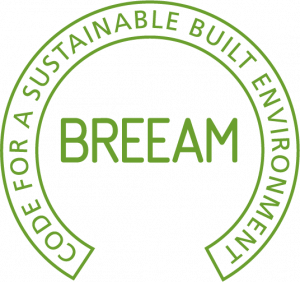BREEAM (Building Research Establishment Environmental Assessment Method) is a widely recognised sustainability assessment method for buildings and infrastructure. It evaluates the environmental performance and sustainability of a project, considering factors like energy efficiency, water usage, materials, and management processes. BREEAM provides a certification rating based on its assessment, with higher ratings indicating a more environmentally friendly and sustainable development.
Developed by the Building Research Establishment (BRE) in the United Kingdom. Aims to assess and improve the sustainability and environmental performance of buildings and developments.
Assessment Categories:
- BREEAM evaluates a range of sustainability categories, including energy, water, materials, waste, pollution, land use, and ecology.
- Each category has specific criteria and benchmarks for performance.
Certification Levels:
- BREEAM offers a certification system with different levels of achievement: Pass, Good, Very Good, Excellent, and Outstanding.
- Higher levels indicate a more environmentally friendly and sustainable development.
Flexibility:
- BREEAM is adaptable to various building types, including residential, commercial, industrial, and public sector projects.
- It can be applied to new constructions, refurbishments, and fit outs.
International Reach:
- While originating in the UK, BREEAM has been adopted in many countries around the world.
- Different countries may have their own adaptations of BREEAM standards to align with local building practices and regulations.
Assessment Process:
- Projects undergo a comprehensive assessment process, involving design, construction, and post-construction phases.
- Assessors evaluate project documentation and conduct site inspections.
- Performance is measured against BREEAM criteria, and scores are assigned to each category.
Benefits:
- BREEAM certification demonstrates a commitment to sustainable building practices and environmental responsibility.
- It can enhance a building’s market value and attractiveness to tenants and investors.
- Reduces operational costs through energy and resource efficiency measures.
- Promotes occupant well-being and health through improved indoor environmental quality.
Continuous Improvement:
- BREEAM standards are periodically updated to reflect advancements in sustainable building practices and evolving environmental priorities.
- Building owners and developers are encouraged to pursue ongoing improvements to maintain or upgrade their BREEAM certification.
Industry Recognition:
- BREEAM is widely recognised by government agencies, industry professionals, and financial institutions as a benchmark for sustainable building performance.
Sustainability Goals:
- BREEAM supports global sustainability goals, such as reducing greenhouse gas emissions, conserving resources, and enhancing the resilience of the built environment.
Customisation:
- BREEAM can be tailored to specific project goals and requirements, allowing for flexibility in achieving sustainability targets.

